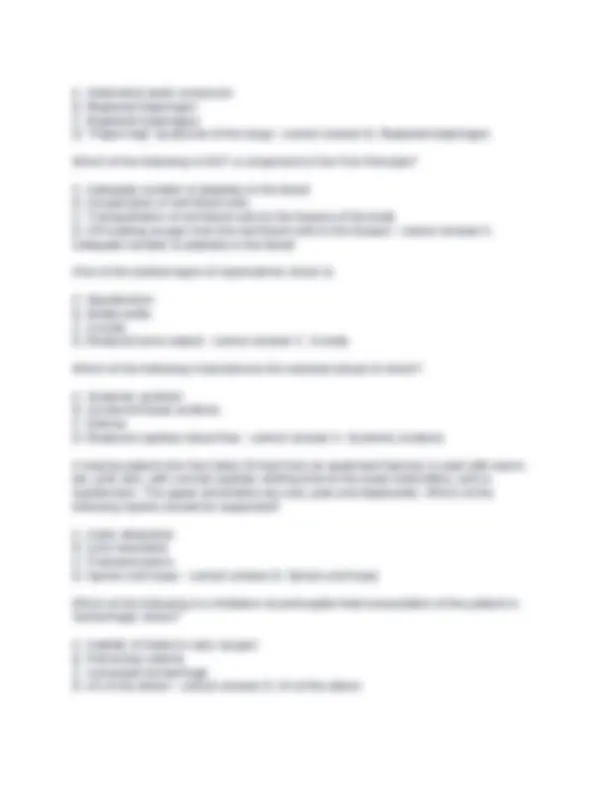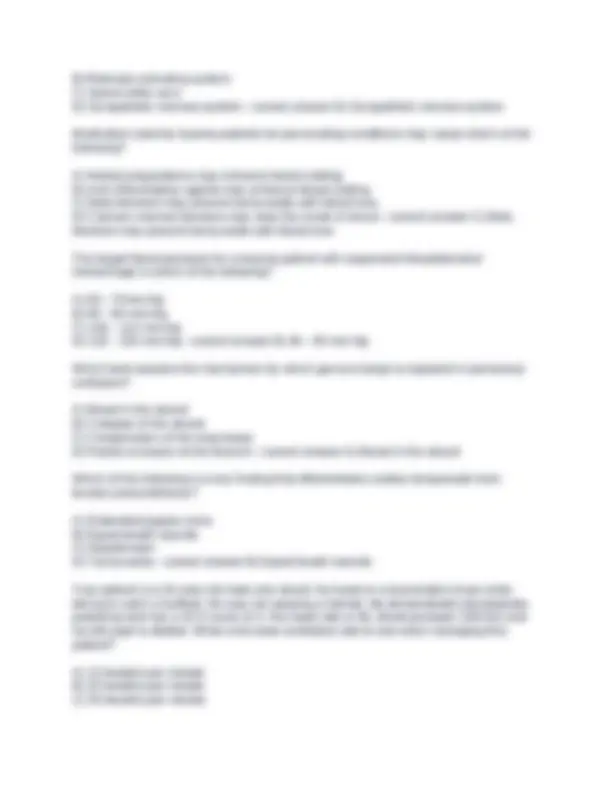











Study with the several resources on Docsity

Earn points by helping other students or get them with a premium plan


Prepare for your exams
Study with the several resources on Docsity

Earn points to download
Earn points by helping other students or get them with a premium plan
Community
Ask the community for help and clear up your study doubts
Discover the best universities in your country according to Docsity users
Free resources
Download our free guides on studying techniques, anxiety management strategies, and thesis advice from Docsity tutors
PHTLS Pre & Post Test questions and answers 2023
Typology: Exams
1 / 15

This page cannot be seen from the preview
Don't miss anything!










The displacement of tissue away from the path of a projectile, both temporarily and permanently, is known as: A. Conization B. Cavitation C. Crepitation D. Contusion - correct answer B. Cavitation The single most important factor in determining the potential for injury due to energy exchange is: A. Mass of the bodies involved B. Velocity of the bodies involved C. Density of the tissues involved D. Surface area of the impact involved - correct answer B. Velocity of the bodies involved In the management of shock, isotonic crystalloid solutions, such as Ringer's, are preferred because: A. The protein molecules in crystalloid solutions act as volume expanders B. These fluids draw interstitial fluid into the vascular space to enhance volume C. These solutions will stay in the vascular space longer than water solutions, such as D5W D. Their pH enhance oxygen delivery to the tissues - correct answer C. These solutions will stay in the vascular space longer than water solutions, such as D5W With respect to the distance of a fall, which of the following is a guideline for determining a critical fall? A. 3 times the height of the patient B. 2 times the height of the patient C. 5 times the height of the patient D. 1 ½ times the height of the patient - correct answer A. 3 times the height of the patient The phase of an explosion, or blast, in which hollow organs are squeezed and may rupture is called the __________ phase.
A. Tertiary phase B. Quaternary phase C. Secondary phase D. Primary phase - correct answer D. Primary phase During the primary survey and management of a trauma patient, the E in ABCDE stands for _________? A. Edema B. Eyes & ears C. Expose/Environment D. Electrical therapy - correct answer C. Expose/Environment The time in which surgical intervention can make a difference in patient outcome is the __________? A. Golden period B. Golden time C. Golden era D. Golden minutes - correct answer A. Golden period (hour) In the absence of extenuating circumstances, the maximum amount of time it should take to identify and manage immediate threats to life, prepare the patient for transport and begin transport is _________? A. 5 minutes B. 10 minutes C. 15 minutes D. 30 minutes - correct answer B. 10 minutes In which of the following situations is the use of a short spinal immobilization device indicated? A. 28 year old male, unrestrained driver in a frontal impact crash. Awake, asks repeatedly what happened, complains of a headache, has a hematoma on his forehead. BP 122/84, HR 92, VR 20. B. 40 year old female who was pushed down a flight of stairs and is lying prone on the landing between two flights of stairs, complaining of back pain. BP 118/78, HR 100, VR
C. 17 year old female, restrained driver in a frontal impact crash. Awake, pale and diaphoretic, complains of upper right quadrant abdominal pain. BP 100/70, HR 108, VR
D. Retrograde endotracheal intubation - correct answer C. Insertion of an oropharyngeal airway Pericardial tamponade is most likely to occur in which of the following situations? A. Stab wound to the chest B. Fall from a height C. Frontal impact vehicle crash D. Gunshot wound to the chest - correct answer A. Stab wound to the chest Which of the following is the preferred site for needle decompression of a tension pneumothorax? A. 4th intercostal space, midclavicular line, just over the top of the 5th rib B. 4th intercostal space, midclavicular line, just below the 4th rib C. 2nd intercostal space, midclavicular line, just over top of the 3rd rib D. 2nd intercostal space, midclavicular line, just below the 2nd rib - correct answer C. 2nd intercostal space, midclavicular line, just over top of the 3rd rib Which of the following is the mechanism by which pulmonary contusion interferes with oxygenation? A. Inability to generate negative intrapleural pressure B. Decrease in vital capacity due to collapse of the flail segment C. Increased intrathoracic pressure D. Blood and fluid in the alveoli and interstitial spaces of the lung - correct answer D. Blood and fluid in the alveoli and interstitial spaces of the lung Your patient is a 55 year old male who was struck in the right side of the chest with a piece of steel pipe. He presents with uncooperative behavior, his skin is pale and moist, the ventilatory rate is 32, there is a weak radial pulse of 112, and breath sounds are decreased on the right side. The trachea is midline and jugular veins are flat while the patient is supine. There is isolated crepitus over the 4th and 5th ribs in the midaxillary line on the patient's right side. Based on the mechanism of injury and the assessment findings, which of the following is the most likely cause of the patient's signs and symptoms? A. Tension pneumothorax B. Simple pneumothorax C. Pulmonary contusion D. Hemothorax - correct answer D. Hemothorax Deterioration of ventilation and oxygenation after inflation of a PASG in a patient who has sustained a high-pressure compression injury of the abdomen, such as a sudden deceleration with the lap belt placed across the abdomen, most likely represents which of the following injuries?
A. Abdominal aortic aneurysm B. Ruptured diaphragm C. Ruptured esophagus D. "Paper bag" syndrome of the lungs - correct answer B. Ruptured diaphragm Which of the following is NOT a component of the Fick Principle? A. Adequate number of platelets in the blood B. Oxygenation of red blood cells C. Transportation of red blood cells to the tissues of the body D. Off-loading oxygen from the red blood cells to the tissues - correct answer A. Adequate number of platelets in the blood One of the earliest signs of hypovolemic shock is: A. Hypotension B. Bradycardia C. Anxiety D. Reduced urine output - correct answer C. Anxiety Which of the following characterizes the washout phase of shock? A. Systemic acidosis B. Localized tissue acidosis C. Edema D. Reduced capillary blood flow - correct answer A. Systemic acidosis A trauma patient who has fallen 20 feet from an apartment balcony is alert with warm, dry, pink skin, with normal capillary refilling time to the lower extremities, and is hypotensive. The upper extremities are cool, pale and diaphoretic. Which of the following injuries should be suspected? A. Aortic dissection B. Liver laceration C. Fractured pelvis D. Spinal cord injury - correct answer D. Spinal cord injury Which of the following is a limitation of prehospital fluid resuscitation of the patient in hemorrhagic shock? A. Inability of fluids to carry oxygen B. Pulmonary edema C. Increased hemorrhage D. All of the above - correct answer D. All of the above
In the context of the caring for an adult patient with traumatic brain injury who is deteriorating and exhibiting signs of herniation, hyperventilation means ventilating with a BVM and 100% oxygen at a rate of: A. 12 to 16 per minute B. 32 to 40 per minute C. 8 to 12 per minute D. 20 per minute - correct answer D. 20 In the United State, which of the following mechanisms most frequently causes spinal cord injury in adults? A. Shallow water diving B. Vehicle crashes C. Falls D. Pedestrian struck by a vehicle - correct answer B. Vehicle crashes Which of the following presentation indicate spinal cord injury? A. Complete loss of sensory and motor function below the site of injury B. Weakness and parethesia in the upper extremities, but normal function in the lower extremities C. Complete loss of function on one side of the body and loss of pain and temperature sensation on the opposite side D. All of the above - correct answer D. All of the above Of the following, which is the earliest indication of compartment syndrome? A. Paralysis of the affected muscles B. Loss of pulses C. Loss of feeling in the web space between the thumb and index finger or between the first and second toes D. Tense swelling of the involved area - correct answer D. Tense swelling of the involved area A traction splint may be used for which of the following injuries? A. Knee dislocation B. Pelvic fractures C. Femur fractures D. All of the above - correct answer C. Femur fractures Which of the following descriptions meets the criteria for transport to a facility with a burn unit? A. A 49 year old female with a partial thickness burn from her elbow to her shoulder
B. A 25 year old male with an electrical burn across his chest C. A 9 year old make with superficial burns on the backs of both legs D. A 32 year old female with a partial thickness burn about twice the size of her hand on her back - correct answer B. A 25 year old male with an electrical burn across his chest The preferred method of dressing burns in the prehospital setting is: A. Dry sterile dressing B. Moist sterile dressing C. Wet dressings D. Petroleum gauze - correct answer A. Dry sterile dressing In assessing the hypothermic patient in the prehospital setting, the most reliable indicator of the severity of hypothermia is: A. Rectal temperature B. Oral temperature C. Heart rate < 60 D. Presence or absence of shivering - correct answer A. Rectal temperature In the normal child, which general statement is most accurate in comparison with the adult patient? A. Blood pressure is higher, hear rate is higher, and ventilatory rate is higher B. Blood pressure is lower, heart rate is lower, and ventilatory rate is higher C. Blood pressure is lower, heart rate is higher, and ventilatory rate is higher D. Blood pressure is lower, heart rate is higher, and ventilatory rate is lowe - correct answer C. Blood pressure is lower, heart rate is higher, and ventilatory rate is higher A patient who withdraws from painful stimuli, opens eyes on verbal command, and cannot speak because of intubation has a Glasgow Coma Scale of which of the following: A. 8 B. 8T C. 7 D. 7T - correct answer B. 8T (E-3, V-T, M-4) The earliest site for intraosseous infusion is: A. Anterior tibia, just above the tibial tuberosity B. Anterior fibula C. Anterior tibia, just below the tibial tuberosity D. Posterior fibula - correct answer C. Anterior tibia, just below the tibial tuberosity
D. Patient with a knife wound to the chest and a GCS of 15 - correct answer D. Patient with a knife wound to the chest and a GCS of 15 The premise of PHTLS is that: A. EMTs must treat all trauma patient based on protocols B. EMTs are capable of sound patient care judgment, given an adequate knowledge base C. EMTs must work only under on-line medical direction when caring for trauma patients D. EMTs are capable of working independently of medical direction - correct answer B. EMTs are capable of sound patient care judgment, given an adequate knowledge base Which of the following warrants classification of a patient as a critical trauma patient? A. An extremity fracture B. Preexisting major medical problem C. Bleeding from the nose D. Deployment of air bags in a motor vehicle crash - correct answer B. Preexisting major medical problem Which of the following is the foundation of effective trauma care? A. Protocols permitting invasive airway procedures B. The ability to administer large amounts of crystalloid fluids C. The ability to quickly locate and manage life-threatening and potentially life- threatening injuries D. Effective spinal immobilization skills - correct answer C. The ability to quickly locate and manage life-threatening and potentially life-threatening injuries You arrive at the scene of a motor vehicle collision in which a vehicle struck a tree. Which is the best indicator of potential injury? A. Circumference of the vehicle B. Diameter of the tree C. Mass of the vehicle D. Speed of the vehicle - correct answer D. Speed of the vehicle The potential for death or serious injury is greatest in which of the following motor vehicle collisions? A) Down and under B) Ejection from vehicle C) Lateral compression D) Up and over - correct answer B) Ejection from vehicle
Bilateral femur fractures are most often associated with which type of motorcycle crash? A) Angular impact B) Bike-road impact C) Head-on impact D) Rear impact - correct answer C) Head-on impact Which is the preferred fluid for resuscitation of hemorrhagic shock in the prehospital setting? A) 5% dextrose in water B) 7.5% hypertonic saline C) Hetastarch D) Lactated Ringer's - correct answer D) Lactated Ringer's Which is the most common cause of upper airway obstruction in the trauma patient? A) Blood B) Teeth C) Tongue D) Vomitus - correct answer C) Tongue Which is the preferred adjunct device for verifying placement of an endotracheal tube in a patient with a perfusing rhythm? A) End-tidal CO2 monitoring (capnography) B) Esophageal detector device C) Pulse oximeter D) Stethoscope - correct answer A) End-tidal CO2 monitoring (capnography) Which is the most important reason to maintain an open airway in the trauma patient? A) Prevents aspiration and pneumonia B) Prevents hypoxemia and hypercarbia C) Prevents snoring respirations D) Prevents the tongue from blocking the pharynx - correct answer B) Prevents hypoxemia and hypercarbia Essential airway skills include manual clearing of the airway, manual maneuvers, suctioning and which of the following? A) Dual lumen airway B) Endotracheal intubation C) Laryngeal mask airway D) Oropharyngeal airway - correct answer D) Oropharyngeal airway
B) Reticular activating system C) Spinal reflex arcs D) Sympathetic nervous system - correct answer D) Sympathetic nervous system Medication used by trauma patients for pre-existing conditions may cause which of the following? A) Herbal preparations may enhance blood clotting B) Anti-inflammatory agents may enhance blood clotting C) Beta blockers may prevent tachycardia with blood loss D) Calcium channel blockers may slow the onset of shock - correct answer C) Beta blockers may prevent tachycardia with blood loss The target blood pressure for a trauma patient with suspected intraabdominal hemorrhage is which of the following? A) 60 - 70mm Hg B) 80 - 90 mm Hg C) 100 - 110 mm Hg D) 120 - 130 mm Hg - correct answer B) 80 - 90 mm Hg Which best explains the mechanism by which gas exchange is impaired in pulmonary contusion? A) Blood in the alveoli B) Collapse of the alveoli C) Compression of the lung tissue D) Partial occlusion of the bronchi - correct answer A) Blood in the alveoli Which of the following is a key finding that differentiates cardiac tamponade from tension pneumothorax? A) Distended jugular veins B) Equal breath sounds C) Hypotension D) Tachycardia - correct answer B) Equal breath sounds Your patient is a 20 year old male who struck his head on a teammate's knee while diving to catch a football. He was not wearing a helmet. He demonstrates decerebrate posturing and has a GCS score of 4. His heart rate is 58, blood pressure 180/102 and his left pupil is dilated. What is the best ventilation rate to use when managing this patient? A) 10 breaths per minute. B) 20 breaths per minute. C) 30 breaths per minute.
D) 35 breaths per minute. - correct answer B) 20 breaths per minute A 20 year old female was ejected from her vehicle during a high speed roll-over motor vehicle collision. She has significant bleeding from a large laceration. Your initial assessment reveals a GCS score of 7, systolic blood pressure of 70 mm Hg and pupils that are equal but respond sluggishly to light. After establishing two large bore IV lines, you should titrate the infusion rate to achieve a target blood pressure of at least A) 60 mm Hg. B) 70 mm Hg. C) 80 mm Hg. D) 90 mm Hg. - correct answer D) 90 mm Hg. Which of the following is the preferred prehospital wound management for a patient with a 36% body surface area flame burn? A) Cool moist dressings B) Dry sterile dressings C) Elastic bandages D) Topical ointments - correct answer B) Dry sterile dressings The most immediate life threatening condition resulting from injury to solid abdominal organs is which of the following? A) Acute respiratory failure B) Hemorrhage. C) Multiple organ failure. D) Peritonitis - correct answer B) Hemorrhage. An adult male sustained a deep laceration to his distal thigh. Bright red blood is spurting from the wound. Direct pressure is not controlling the bleeding. What is the most appropriate next step? A) Apply a topical hemostatic agent and transport B) Apply a tourniquet and tighten it until bleeding stops C) Elevate the leg and apply pressure to the femoral artery D) Maintain direct pressure and transport immediately - correct answer B) Apply a tourniquet and tighten it until bleeding stops An 18-year-old female was struck by a car and has sustained an apparent left femur fracture. Communication with her is hampered because she only speaks a foreign language. Which finding, by itself, does not mandate immobilization of the cervical spine? A) Fracture of the femur B) Inability to communicate